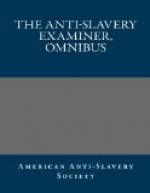“Resolved, That Congress ought not to interfere in any way with slavery in the District of Columbia.” “Ought not to interfere,” carefully avoiding the phraseology of the first resolution, and thus in effect conceding the constitutional power. In a widely circulated “Address to the electors of the Charleston District,” Mr. Pinkney is thus denounced by his own constituents: “He has proposed a resolution which is received by the plain common sense of the whole country as a concession that Congress has authority to abolish slavery in the District of Columbia.”
3. IT HAS BEEN CONCEDED BY THE CITIZENS OF THE DISTRICT. A petition for the gradual abolition of slavery in the District, signed by nearly eleven hundred of its citizens, was presented to Congress, March 24, 1827. Among the signers to this petition, were Chief Justice Cranch, Judge Van Ness, Judge Morsel, Prof. J.M. Staughton, and a large number of the most influential inhabitants of the District. Mr. Dickson, of New York, asserted on the floor of Congress in 1835, that the signers of this petition owned more than half of the property in the District. The accuracy of this statement has never been questioned.
THIS POWER HAS BEEN CONCEDED BY GRAND JURIES OF THE DISTRICT. The Grand jury of the county of Alexandria, at the March term, 1802, presented the domestic slave trade as a grievance, and said, “We consider these grievances demanding legislative redress.” Jan. 19, 1829, Mr. Alexander, of Virginia, presented a representation of the grand jury in the city of Washington, remonstrating against “any measure for the abolition of slavery within said District, unless accompanied by measures for the removal of the emancipated from the same;” thus, not only conceding the power to emancipate slaves, but affirming an additional power, that of excluding them when free. Journal H.R. 1828-9, p. 174.
4. THIS POWER HAS BEEN CONCEDED BY STATE LEGISLATURES. In 1828 the Legislature of Pennsylvania instructed their Senators in Congress “to procure, if practicable, the passage of a law to abolish slavery in the District of Columbia.” Jan. 28, 1829, the House of Assembly of New-York passed a resolution, that their “Senators in Congress be instructed to make every possible exertion to effect the passage of a law for the abolition of Slavery in the District of Columbia.” In February, 1837, the Senate of Massachusetts “Resolved, That Congress having exclusive legislation in the District of Columbia, possess the right to abolish slavery and the slave trade therein.” The House of Representatives passed the following resolution at the same session: “Resolved, That Congress having exclusive legislation in the District of Columbia, possess the right to abolish slavery in said District.”
November 1, 1837, the Legislature of Vermont, “Resolved, that Congress have the full power by the constitution to abolish slavery and the slave trade in the District of Columbia, and in the territories.”




